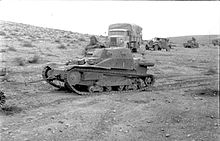L3 / 33


The L3 / 33 was an Italian tankette at the time of World War II .
Before the Second World War, the tankettes were the main equipment of the motorized units of Italy. Mainly in the 1930s about 1400 pieces were produced. The advantages of the tankettes were their small size, their maneuverability and the high speed, which could be used for reconnaissance and reinforcement of infantry units.
The disadvantages were more serious, however, because the weak standard armament, which consisted only of a MG, and the weak armor, the thickness of which was no more than 12 mm at any point, made them similar to the German Panzerkampfwagen I , the British Light Tank Mk VI and the Polish TKS did not become a serious opponent for enemy tanks.
Development history and variants
Development of this tankette began in the late 1920s and, like the T-27, was based on the Vickers-Armstrong Mk.IV Carden-Loyd. Well-known variants are:
- CV 29 (prototype)
- L3 / 33, Carro Veloce 33
- L3 / 35, Carro Veloce 35
- CV Fiat-Ansoldo L38
- L3 cc controcarro (equipped with a Solothurn S18 / 100 anti - tank rifle )
- L3 Lf Lanciafiamme (equipped with a flame thrower)
- Carro Veloce L35 / Lf
- Carro radio
- Carro Veloce Recupero (draft only)
- Passerella (bridge armor)
- Semovente L3 da 47/32
The abbreviation "L3" stands for light tankette / 3 tons, "CV" for "Carro Veloce", the two-digit numbers for the start of production of the variants.
commitment
The L3 / 33 was used in the Spanish Civil War in the ranks of the Italian Corpo Truppe Volontarie . It was not up to the Soviet T-26 on the Republican side due to its insufficient armament and weak armor.
Tankette units suffered heavy losses in North Africa during World War II, as they were often used like tank units and were far inferior to the British Matilda or Crusader tanks . As early as 1940 the L3 / 33 was completely unsuitable for use at the front.
Technical specifications
- Production period: 1933–1935
- Crew: 2 people
- Length: 3.03 meters
- Width: 1.4 meters
- Height: 1.2 meters
- Mass: 2.7 t
- Ability to cross: 1.45 meters
- Climbing ability: 65 cm
- Wading ability: 70 cm
- Drive: liquid-cooled Fiat CV 3-005
- Speed: 42 km / h
- Driving range: 110 km
- Armament:
- a 6.5 mm Breda machine gun with 2170 rounds
- Armor:
- Front: 12 mm
- Sides: 6 mm
- Motor cover: 6 mm
Importers
-
 Afghanistan - an unknown number L3 / 35 were delivered between 1937 and 1939
Afghanistan - an unknown number L3 / 35 were delivered between 1937 and 1939 -
 Bolivia - an unknown number was delivered in 1937/1938
Bolivia - an unknown number was delivered in 1937/1938 -
 Brazil - 23 L3 / 35, 5 were with the Breda 13.2 mm and 18 to the Madsen 7.92 mm equipped
Brazil - 23 L3 / 35, 5 were with the Breda 13.2 mm and 18 to the Madsen 7.92 mm equipped -
 Bulgaria - 14 L3 / 33 delivered from 1935
Bulgaria - 14 L3 / 33 delivered from 1935 -
 Republic of China
Republic of China
-
 Iraq - an unknown number L3 / 35 were delivered in 1938
Iraq - an unknown number L3 / 35 were delivered in 1938 -
 Austria - 72 vehicles, 36 L3 / 33 (from 1935) and 36 L3 / 35 (from 1937). All vehicles were from the army to the Schwarzlose- machine gun 7.12 retrofitted
Austria - 72 vehicles, 36 L3 / 33 (from 1935) and 36 L3 / 35 (from 1937). All vehicles were from the army to the Schwarzlose- machine gun 7.12 retrofitted -
 Spain - an unknown number was National Spanish army from Corpo Truppe Volontarie during the Spanish Civil War left
Spain - an unknown number was National Spanish army from Corpo Truppe Volontarie during the Spanish Civil War left -
 Hungary - a not inconsiderable number were delivered from 1935 and put into service by the Royal Hungarian Army under the designation 35M Ansaldo
Hungary - a not inconsiderable number were delivered from 1935 and put into service by the Royal Hungarian Army under the designation 35M Ansaldo
Comparable types
-
 German Empire : Panzerkampfwagen I
German Empire : Panzerkampfwagen I
-
 United Kingdom : Light Tank Mk VI
United Kingdom : Light Tank Mk VI
-
 France : AMR 33 VM
France : AMR 33 VM
-
 Poland : TKS
Poland : TKS
-
 Soviet Union : T-27
Soviet Union : T-27
See also
Individual evidence
- ↑ Nicola Pignato: Italian medium tanks in action. 2001, ISBN 978-0-89747-426-9 .
Web links
- Technical data and variants L3 / 33 (Engl.)

